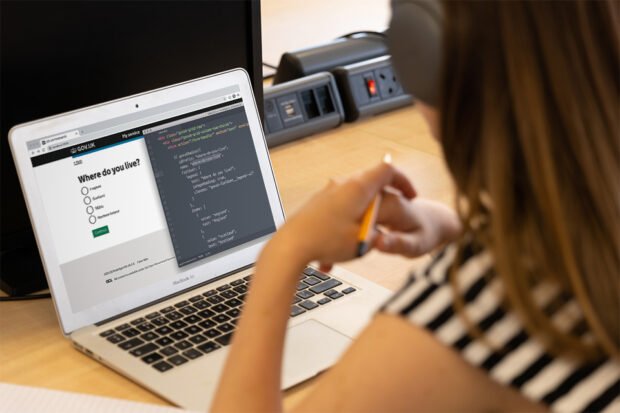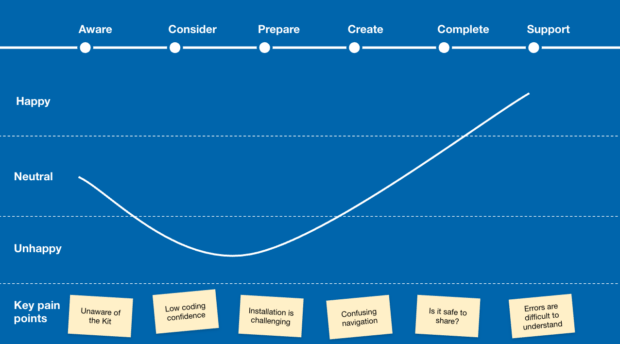
When we launched Version 13 of the Prototype Kit we said that the updates made creating and updating prototypes easier for all users, particularly those getting started with the Kit.
Now that Version 13 is live we wanted to understand more about the people who are not currently using the Kit or are very new to the Kit and what impact the changes in Version 13 have had on new and existing users.
As a team we are focusing on improving the Kit in line with user needs. In this blog, we will explain how user research has helped us understand what impact the changes in Version 13 had on both new and existing users.
User research is an essential part of creating and improving digital services. It helps our teams in government to understand the needs, behaviours and preferences of our users, so that we can inform design decisions and effectively improve our services.
First-time user experience
Our first step was to map out the user journey, looking at what we knew already and where we needed more information.

To expand our knowledge of the ‘first-time user’ user group we set up research to capture their first interactions with the GOV.UK Prototype Kit, with no preconceived ideas.
This round of research focused on people who had never used the Prototype Kit before and had very limited coding experience or knowledge. This also included users who were self-declared novices, and had not used Version 13 before but may have used previous versions of the Prototype Kit.
In the research session, we asked the users to install the Kit and follow the tutorials on their own and to create a prototype.
Our aims were to:
- Capture the initial first impressions
- Base findings not on previous experience
- Identify any reasons why first-time users stop using the Kit or don’t get through the installation process
Version 13 is much more accessible
Our user research participants really liked Version 13 of the Kit because:
- “It’s much more accessible to use than Figma or Adobe”
- It’s easy and quick to use
- It’s interactive and “much more like the real thing”
This positive feedback came from the ability for the users to quickly learn how to use the Kit, and to get to the point of a working prototype. The users felt like they had accomplished something and demonstrated high feelings of satisfaction.
The results also showed that Version 13 of the Prototype Kit increased engagement with the product through gamification, with one user stating that Version 13 “feels more like a game, whereas before it felt like a school lesson.”
Users also noted that Version 13 was more visual which makes it easier to understand cause and effect, as when you make changes on the new user interface, you can see the changes happen live on your prototype.
You don’t need to know how to code
Our research demonstrated that users do not need to know how to code to use the Kit. Once the users had moved past the installation phase, the research showed that users could competently create a simple prototype, and have it up and running fairly quickly. New users built up confidence quickly during the creation stage of the prototype, due to the step by step instructions they received in the tutorials.
Although users initially found the installation process “confusing”, “overwhelming” and “difficult”, once using the Kit the positivity increased dramatically. The users soon followed by saying they were “making some progress” and that their “feelings of engagement and comfortableness are improving”. One user talked about enjoying using the Kit in the browser and that it was “doing the whole magical thing in the background.” Later in the journey, users highlighted pain points when identifying and fixing errors, mainly due to not being as comfortable with the coding language used.

Having some coding experience is still an aid, particularly when working on more complex prototypes, but this should not be a barrier to use. Actually, users felt that the Kit could be used to help designers to learn more about coding.
Changing the Kit to meet the user needs
Our research has informed several recommendations for the continuous improvements to the Prototype Kit. Our list of improvements so far include:
- Streamline the installation and set up process, removing steps and automating some of the process.
- Simplify the navigation of the Prototype Kit, making it easier for new and existing users to find the information they need.
- Improve the content of the error information provided, making it easier for users to fix any errors that occur.
- Add visuals and content to the tutorials and guides, to help users understand more about coding and the software they are installing.
What’s next
This research showed us that the improvements we have made so far with Version 13 have been beneficial, and have produced a much better user experience. By implementing our recommendations we believe that the GOV.UK Prototype Kit will continue to improve, particularly for new users and for those with no or little coding experience.
We want to constantly improve and reach other user groups, with varying experiences, backgrounds and needs. If you are interested in helping us with this work, please sign up for our research panel via this form.


4 comments
Comment by Levon Kostandyan posted on
Hey GDS team, really love the research that you done so far, looks amazing!
I have a one small question regarding the journey map, there is column right after "Consideration" what is mapped there and how it helped to get your research done?
Thanks!
Comment by Alina Graham posted on
Hello, thank you so much for your positive feedback on the research.
In regards to the journey map, the section to the right of “consideration” was “ideation and sketching”. It was important for us to capture the findings we had in this area, although this stage isn’t directly related to the Prototype Kit. It is describing a stage where the users may complete paper prototypes or lower fidelity prototypes. These are not often done on the Prototype Kit. So it was important to understand current journeys for that and how that links into the journey using the Prototype Kit.
I hope that answers your question,
Many thanks,
Alina
Comment by Suryanaga Poyzer posted on
Good to read all this. Have you looked anymore at setting the Kit up on Glitch, and providing instructions for people to clone on there instead of via GitHub? Could be much easier for people and doesn't require saving/installing things to the local device.
Comment by Joe Lanman, Designer, GOV.UK Prototype Kit posted on
Thanks! Glitch is a great platform. Unfortunately when we looked into it, the overall way of working was so different it was hard to document and support both approaches. For example Glitch does not stay in sync with GitHub, you have to manually import and export.
We are doing research into what blocks people from using the kit, and may revisit Glitch and other online platforms as part of that work.
Joe Lanman, Designer, GOV.UK Prototype Kit